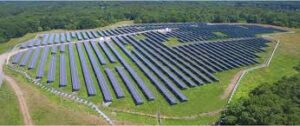 (888) 895-1776
(888) 895-1776
 Garrett Hourigan
Garrett Hourigan  Jun 17, 2024
Jun 17, 2024  0 Comment
0 Comment 
What is Community Solar?
Community solar allows for residential energy users who cannot install their own rooftop solar panels to join shared solar farms as subscribers or shareholders. An ideal candidate for community solar may be someone who lives in an apartment or rents as they do not have the ability to install personal solar panels on their residence. With community solar, multiple participants share the benefits generated from the project. These beneficiaries may be individuals, businesses, or nonprofits who typically subscribe to or own a portion of the energy generated by the project. These participants receive electric bill credits for their portion of the energy generated while the excess energy is either stored for later use or fed into the grid for active use elsewhere.
How Community Solar Works
The first step to any community solar project is development and installation. The solar arrays can be built on various types of land including open land, brownfields, and rooftops. After the development and installation phase is completed the project begins operation. It is at this point that community members are able to participate through subscription or ownership to a portion of the project. The local utility company then pays the community solar provider or providers (if ownership is split) for the generated energy. In turn, the community members receive energy credits that are usually directly applied to their monthly electric bill.
Types of Community Solar
There are three main types of community solar models being Utility Ownership, Third-Party-Ownership, and Direct Ownership. Utility Ownership is when the utility administers, owns and operates the solar project. Typically, Utility-Owned community solar projects are seen as simple and reliable as the utility companies often have the necessary legal, financial, and operational infrastructure for proper project implementation.
Third-Party-Ownership is when a third-party is responsible for the construction, ownership, and operation of a community solar project. This type of ownership often offers more competitive pricing as third-party companies are known to offer no-upfront cost plans, meaning community members only pay the agreed upon subscription price every month.
Direct Ownership is when subscribers or community members make an up-front payment to purchase solar panels from a utility or third-party company. Under Direct Ownership, the utility or third-party company is still responsible for constructing and operating the community solar project. In some cases, the utility or third-party company provides the subscriber with an REC (Renewable Energy Certificate), which acts as proof of energy generated and is measured in megawatt hours. This type of ownership offers the highest potential returns for subscribers but is also associated with the highest initial costs.
Benefits of Community Solar
Community solar offers many benefits due to its ability to engage multiple participants through a single project. The first major benefit of community solar is cost savings. Community solar projects work to lower electricity bills for all participants, often through credits which can be applied to subscribers’ monthly electricity bills. Beneficiaries also see more stable energy costs in the long term as the community solar project creates a constant and predictable amount of energy. Another major benefit of community solar is improved grid health. By generating energy close to the point of consumption, these localized projects put less overall stress on the grid allowing for energy to be allocated by demand. Lastly, community solar projects represent a great path towards equitable access to renewable energy sources. These projects can be utilized in areas with little to no access to renewable energy, therefore allowing for greater access to clean energy.
The Future of Community Solar
As time moves on, the future for community solar looks bright. The utilization of community solar is forecasted to double by 2028. However, this growth rate could be accelerated depending on changes in state and federal government regulation surrounding localized renewable energy projects. With adequate funding and implementation, community solar could play a pivotal role in the transition towards a sustainable future.